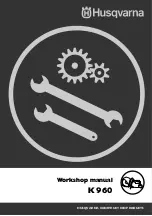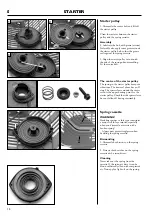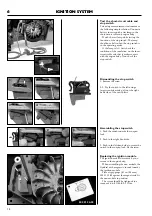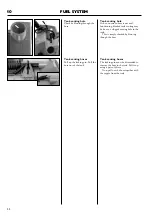
STARTER
5
11
Starter pawls
Function
In principle the starter pawls have two positions that are determined by the
centrifugal force generated by the rotation of the flywheel.
When the engine is at a standstill the springs push the starter pawls towards
the centre, which when starting then grip the starter pulley's metal sleeve.
As soon as the engine starts, the starter pawls are thrown out of the starter
pulley's centre to their outer positions.
Consequently it is important for the function that the springs are in full
working order and that the starter pawls do not jam. The starter pawls must
not be lubricated!
Inspection
Check that the springs are in full wor-
king order and that the starter pawls do
not jam. Dismantle and clean if necessary.
Dismantling/assembling
The starter pawls are fitted using a
shoulder screw. Note the position of the
springs in relation to the flanges on the
flywheel so that they are fitted correctly.
NOTE! Do not forget the washer (A) that
should lie under the starter pawls against
the flywheel.
Assembly
It is important that the spring does not
get caught between the starter pawls and
the flywheel. The follow ing method is
recommended when assembling:
1. Press the spring into position in the
flywheel.
2. Fit the washer.
3. Screw on the starter pawls.
4. Make the simplest of “special tools”:
Bend the end of a thin steel wire and use
this to pull the spring under the starter
pawls to the mount ing on the opposite
side.
Fitting the starter
Do as follows so that the starter pawls
come into the right position against the
starter pulley sleeve: First pull out the
cord about a half meter. Keep this posi-
tion when the starter is set against the
machine and slowly release and the starter
pawls will take on the correct position.
Tighten the four screws on the starter to a
torque of 5–6.6 lbf·ft/7–9 Nm.
A
1
2
3
4













































